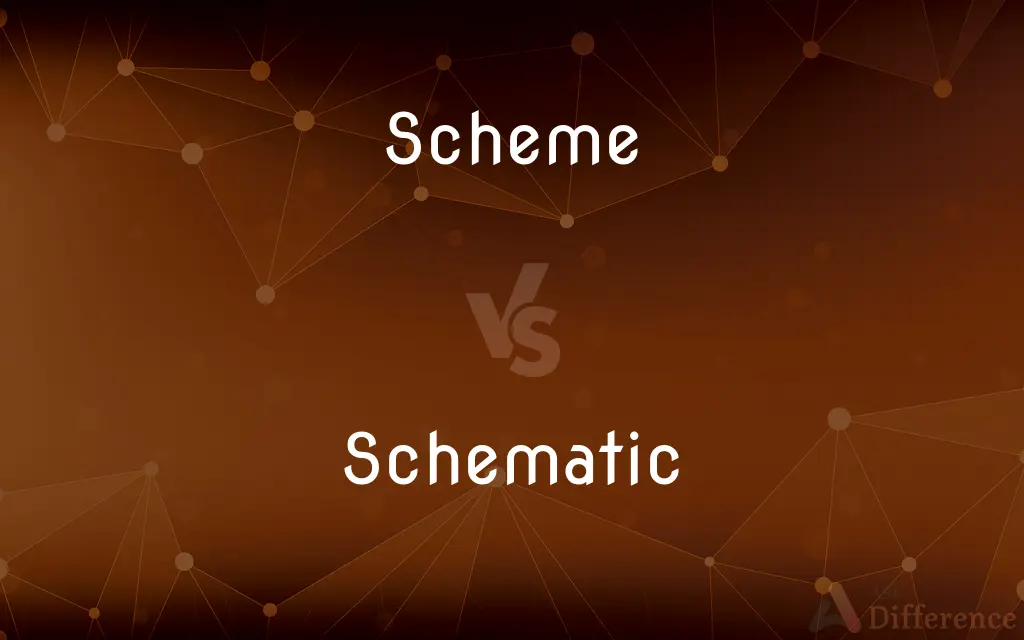Scheme vs. Schematic — What's the Difference?
By Fiza Rafique & Maham Liaqat — Updated on April 27, 2024
A scheme is a systematic plan or arrangement for attaining some particular object or putting a particular idea into effect, whereas a schematic is a diagram or drawing that outlines and explains the parts, operation, or theory of something.

Difference Between Scheme and Schematic
Table of Contents
ADVERTISEMENT
Key Differences
A scheme often refers to an elaborate and systematic plan of action, designed to achieve a specific goal or to solve a problem. It typically involves a series of steps or procedures that are to be followed. On the other hand, a schematic is a type of diagram that represents the elements of a system using abstract, graphic symbols rather than realistic pictures, often used in engineering or software design.
Schemes are usually more conceptual and can apply to a wide range of contexts, from business strategies to scientific research plans. Whereas schematics are more technical and specific, primarily used to communicate complex information in a simplified and visual format, such as electrical circuits or architectural plans.
When developing a scheme, the focus is on the strategy and structure of the plan, which can be detailed or broad. On the other hand, creating a schematic involves focusing on the clarity and efficiency of communication, making sure that each part is correctly represented and easy to understand.
In implementation, a scheme might require a step-by-step execution or adherence to guidelines, aiming for a particular outcome. Conversely, a schematic serves as a reference point that guides the building, troubleshooting, or modifying of components in a system.
The purpose of a scheme is to organize thoughts and actions to achieve a specific result, which could involve multiple phases and adjustments. In contrast, the purpose of a schematic is to clearly depict the components and connections within a system, ensuring that anyone who reads it can understand the system’s design and function.
ADVERTISEMENT
Comparison Chart
Definition
A systematic plan or arrangement.
A diagram or drawing explaining parts.
Purpose
To achieve specific objectives.
To communicate technical details.
Usage Context
Business, science, strategies.
Engineering, electronics, architecture.
Focus
Strategy and structure of a plan.
Clarity and communication of elements.
Nature
Conceptual and variable.
Technical and precise.
Compare with Definitions
Scheme
An organized framework of action.
Her scheme to improve sales involved intensive training.
Schematic
A diagram that represents the elements of a system.
The engineer studied the schematic for the new circuit.
Scheme
A design or program of action.
The government’s health scheme benefits millions.
Schematic
A plan or drawing that simplifies complex structures.
The architect presented the building’s schematic.
Scheme
A plan or system for achieving something.
The new scheme for waste management is more efficient.
Schematic
A symbolic representation.
The schematic made the complex machine easier to understand.
Scheme
A plotted strategy, sometimes with a negative connotation.
His scheme to take over the company was thwarted.
Schematic
A visual summary of a system.
The schematic provided a quick overview of the product’s design.
Scheme
A systematic arrangement of ideas.
The educational scheme was revised to be more inclusive.
Schematic
A blueprint or plan used in design.
The team followed the schematic during the project’s development.
Scheme
A systematic plan of action
"Did you ever carry out your scheme of writing a series of sonnets embodying all the great epochs of art?" (Edith Wharton).
Schematic
A schematic, or schematic diagram, is a representation of the elements of a system using abstract, graphic symbols rather than realistic pictures. A schematic usually omits all details that are not relevant to the key information the schematic is intended to convey, and may include oversimplified elements in order to make this essential meaning easier to grasp.
Scheme
A secret or devious plan; a plot
A scheme to defraud investors.
Schematic
Of, relating to, or in the form of a scheme or diagram.
Scheme
An orderly plan or arrangement of related parts
An irrigation scheme with dams, reservoirs, and channels.
Schematic
A structural or procedural diagram, especially of an electrical or mechanical system.
Scheme
A chart, diagram, or outline of a system or object.
Schematic
Represented too simply or in an overly formulaic way, reflecting a shallow or incomplete understanding of complex subject matter
Scheme
To contrive a plan or scheme for; plot
Scheming their revenge.
Schematic
Sketchy, incomplete
Scheme
To make plans, especially secret or devious ones.
Schematic
Relating to a schema
Scheme
An artful deviation from the ordinary arrangement of words.
Schematic
A simplified line drawing used by scientists, engineers, technologists and others to illustrate a system at an abstract level. Schematic drawings often use standard symbols for clarity.
I'll have to study the schematics for the new integrated circuit before I can create a good layout.
Scheme
(astrology) A representation of the aspects of the celestial bodies for any moment or at a given event.
Schematic
Of or pertaining to a scheme or a schema.
Scheme
A systematic plan of future action.
Schematic
Diagram of an electrical or mechanical system
Scheme
A plot or secret, devious plan.
Schematic
Represented in simplified or symbolic form
Scheme
An orderly combination of related parts.
Scheme
A chart or diagram of a system or object.
Scheme
(mathematics) A mathematical structure that enlarges the notion of algebraic variety in several ways, such as taking account of multiplicities and allowing "varieties" defined over any commutative ring (e.g. Fermat curves over the integers).
Scheme
A council housing estate.
Scheme
(internet) Part of a uniform resource identifier indicating the protocol or other purpose, such as
http: or news:.Scheme
A portfolio of pension plans with related benefits comprising multiple independent members.
Scheme
(intransitive) To plot, or contrive a plan.
Scheme
(transitive) To plan; to contrive.
Scheme
A combination of things connected and adjusted by design; a system.
The appearance and outward scheme of things.
Such a scheme of things as shall at once take in time and eternity.
Arguments . . . sufficient to support and demonstrate a whole scheme of moral philosophy.
The Revolution came and changed his whole scheme of life.
Scheme
A plan or theory something to be done; a design; a project; as, to form a scheme.
The stoical scheme of supplying our wants by lopping off our desires, is like cutting off our feet when we want shoes.
Scheme
Any lineal or mathematical diagram; an outline.
To draw an exact scheme of Constantinople, or a map of France.
Scheme
A representation of the aspects of the celestial bodies for any moment or at a given event.
A blue silk case, from which was drawn a scheme of nativity.
He forms the well-concerted scheme of mischief;'T is fixed, 't is done, and both are doomed to death.
Artists and plans relieved my solemn hours;I founded palaces, and planted bowers.
Scheme
To make a scheme of; to plan; to design; to project; to plot.
That wickedness which schemed, and executed, his destruction.
Scheme
To form a scheme or schemes.
Scheme
An elaborate and systematic plan of action
Scheme
A statement that evades the question by cleverness or trickery
Scheme
A group of independent but interrelated elements comprising a unified whole;
A vast system of production and distribution and consumption keep the country going
Scheme
An internal representation of the world; an organization of concepts and actions that can be revised by new information about the world
Scheme
A schematic or preliminary plan
Scheme
Form intrigues (for) in an underhand manner
Scheme
Devise a system or form a scheme for
Common Curiosities
What is the importance of a schematic in troubleshooting?
Schematics are essential in troubleshooting as they help identify and isolate components within a system, allowing for precise corrections.
Can a scheme be used in multiple industries?
Yes, schemes can be adapted and utilized across various industries for planning and strategic purposes.
What types of professionals frequently use schematics?
Engineers, architects, and designers frequently use schematics to plan, design, and communicate technical details of systems.
Can schematics be used for non-technical purposes?
Yes, schematics can also be used in fields like business or education to visually summarize complex processes or systems.
How do the contexts differ in which schemes and schematics are used?
Schemes are generally used in strategic and planning contexts, while schematics are used in technical fields to depict and explain systems.
What is the primary purpose of a scheme?
The primary purpose of a scheme is to outline a systematic plan to achieve specific goals.
How does a scheme differ from a simple plan?
A scheme is typically more comprehensive and strategic than a simple plan, often involving multiple steps or a structured approach to achieving broader objectives.
What are common elements found in a schematic?
Common elements in a schematic include symbols for components, connection lines, and sometimes annotations that explain functionality.
How can the effectiveness of a scheme be evaluated?
The effectiveness of a scheme can be evaluated through metrics such as achievement of goals, efficiency in implementation, and overall outcomes compared to initial objectives.
How do schematics aid in engineering?
Schematics aid in engineering by providing clear and simplified visual representations of systems, facilitating understanding and construction.
What should be considered when creating a schematic?
When creating a schematic, it's important to ensure clarity, accuracy, and the use of standardized symbols for universal understanding.
What role do schematics play in product development?
In product development, schematics are crucial for outlining product design, ensuring all components fit together correctly, and facilitating the manufacturing process.
Can a scheme be unethical?
Yes, schemes can be unethical if they involve deceit, manipulation, or harm to others to achieve objectives.
How can a scheme be effectively implemented?
Effective implementation of a scheme often requires careful planning, resource allocation, clear communication, and ongoing monitoring and adjustments.
Are there software tools designed to help create schematics?
Yes, there are several software tools available, like AutoCAD, Eagle, and Visio, that specialize in creating detailed and accurate schematics.
Share Your Discovery

Previous Comparison
Wine vs. Liquor
Next Comparison
Unicellular vs. MulticellularAuthor Spotlight
Written by
Fiza RafiqueFiza Rafique is a skilled content writer at AskDifference.com, where she meticulously refines and enhances written pieces. Drawing from her vast editorial expertise, Fiza ensures clarity, accuracy, and precision in every article. Passionate about language, she continually seeks to elevate the quality of content for readers worldwide.
Co-written by
Maham Liaqat















































